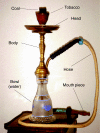Motives, beliefs and attitudes towards waterpipe tobacco smoking: a systematic review
- PMID: 23816366
- PMCID: PMC3706388
- DOI: 10.1186/1477-7517-10-12
Motives, beliefs and attitudes towards waterpipe tobacco smoking: a systematic review
Abstract
Background: In spite of the negative health effects of waterpipe tobacco smoking, its use is becoming more common. The objective of this study is to systematically review the medical literature for motives, beliefs and attitudes towards waterpipe tobacco smoking.
Methods: We electronically searched MEDLINE, EMBASE, and the ISI the Web of Science in January 2012. We included both quantitative and qualitative studies. We selected studies and abstracted data using standard systematic review methodology. We synthesized data qualitatively.
Results: We included 58 papers reporting on 56 studies. The main motives for waterpipe tobacco smoking were socializing, relaxation, pleasure and entertainment. Peer pressure, fashion, and curiosity were additional motives for university and school students while expression of cultural identity was an additional motive for people in the Middle East and for people of Middle Eastern descent in Western countries. Awareness of the potential health hazards of waterpipe smoking was common across settings. Most but not all studies found that the majority of people perceived waterpipe smoking as less harmful than cigarette smoking. Waterpipe smoking was generally socially acceptable and more acceptable than cigarette smoking in general. In Middle Eastern societies, it was particularly more acceptable for women's use compared to cigarette use. A majority perceived waterpipe smoking as less addictive than cigarette smoking. While users were confident in their ability to quit waterpipe smoking at any time, willingness to quit varied across settings.
Conclusions: Socializing, relaxation, pleasure and entertainment were the main motives for waterpipe use. While waterpipe users were aware of the health hazards of waterpipe smoking, they perceived it as less harmful, less addictive and more socially acceptable than cigarette smoking and were confident about their ability to quit.
Figures
References
-
- Akl EA, Gaddam S, Gunukula SK, Honeine R, Abou Jaoude P, Irani J. The effects of waterpipe tobacco smoking on health outcomes: a systematic review. Int J Epidemiol. 2010. p. . [Epub ahead of print] - PubMed
Publication types
MeSH terms
LinkOut - more resources
Full Text Sources
Other Literature Sources
Molecular Biology Databases



